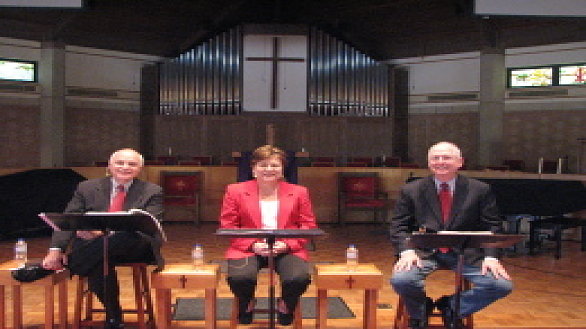Photo: Participants in a debate sponsored by UM Men of Southwest Texas Conference: (from left) the Rev. Tim McClendon, Dr. Kim Cape, and Jay Brim. Photo by Cary Boddeker
SAN ANTONIO –– Participants in a March 31 debate disagreed on whether a proposed new structure will increase the liability of the United Methodist Church and put millions of dollars of property and assets at risk.
Delegates to General Conference, meeting later this month, will consider implementing a structure that would eliminate the governing boards of nine general agencies and replace them under a 15-member Center for Connectional Mission and Ministry and a 45-member General Council for Strategy and Oversight. The proposed structure evolved from a multi-year “Call to Action” study to increase the number of “vital congregations.”
The general counsel for the United Methodist Council on Finance and Administration had earlier warned that the presence of an executive general secretary for the Center for Connectional Mission and Ministry does provide a target for litigants seeking millions of dollars in damages.
Jay Brim, an attorney and chair of the legislative committee that drafted the proposal, disagrees with the warning and suggests that the counsel’s warning is affected by the fact that the proposed structure would eliminate the governing board of the Nashville-based finance agency. He said other attorneys disagree.
“Fear not,” said Brim.
“And I say, ‘Fear’,” said the Rev. Tim McClendon, a district superintendent in the South Carolina Annual Conference and also a member of the Connectional Table Legislative Committee.
McClendon noted that it took 22 years and $27 million for the denomination to work its way through the bankruptcy of Pacific Homes. In that case, a retirement home offered life-time care to residents who gave the California-Pacific Conference all their assets. When too many residents outlived their contributions, the homes went bankrupt and families of residents sued the conference and the denomination.
“We really won’t know whether our liability has increased until the first person sues the denomination,” said McClendon.
“Why would we establish a structure that poses that risk,” asked Dr. Kim Cape, top staff executive of the United Methodist Board of Higer Education and Ministry and the third member of the panel discussing the proposed structure.
The panel was assembled by United Methodist Men of the Southwest Texas Annual Conference. Gil Hanke, top staff executive of the General Commission on United Methodist Men, served as the moderator of the three-person panel.
Hanke began the debate pointing out that all four participants were friends and had worked together on general church issues. “But we see the different restructure plans from significantly different perspectives.” “In addition to providing good information, we also wanted to model that these close associates that love this church can debate in a civil manner and still remain friends. And I think we accomplished both goals,” Hanke related after the event.
Diversity
Asked whether a 15-member Center for Connectional Mission and Ministry can provide for the diversity needed, Brim said the legislation failed to define the diversity that will be needed on that committee, but the issue will be corrected in Tampa, site of the legislative assembly. He said there will be fewer members, but diversity can be maintained. “The emphasis will be on quality.”
McClendon argued that there is no way a 15-member body can include all representatives of all the groups in the global church. Reading the description in the proposed legislation, McClendon pointed out that Jesus Christ and 11 of his disciples would not quality to sit on the 15 member board, but Judas would.
Cape noted that the General Board of Higher Education and Ministry and other general agencies are already proposing reductions in the size of their governing boards, and she assured the participants in San Antonio and those viewing the debate on the Internet that her board plays an important role in planning and accountability. Cape pointed out that the reduction in board members and other actions taken by all the general agencies were not considered in the proposed legislation.
The debate also included other plans to restructure the church from MFSA and a second proposal called “Plan B.”
The Connectional Table proposal can be found at: http://www.umc.org/atf/cf/%7Bdb6a45e4-c446-4248-82c8-e131b6424741%7D/GC2012CONNECTIONALTABLE%20PETITIONS.PDF.
The MFSA proposal can be found at: http://www.mfsagc12.org/A%20New%20United%20Methodist%20Administrative%20Order.pdf
A news report on Plan B can be found at:
http://www.umc.org/site/apps/nlnet/content3.aspx?c=lwL4KnN1LtH&b=5259669&ct=11666483
Visit a UMN news article on the debate
http://www.umc.org/site/apps/nlnet/content3.aspx?c=lwL4KnN1LtH&b=5259669&ct=11678525
To watch a video of the debate, visit
http://www.ourchurchvideos.com/78248/umcswtx/videos/load/recent


